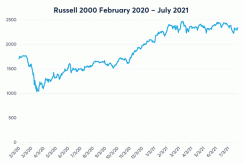Jim Iuorio, CME Group
AT A GLANCE
- In the time since the pandemic took hold in the United States, the Russell 2000 has looked like a barometer for economic confidence
- The directional differences in the Russell and the Nasdaq in the pandemic era have created new opportunities for retail traders
Not surprisingly, the pairs trade between the Nasdaq 100 and the Russell 2000 has made its way onto many traders’ radar. February 21, 2020 marked the first day that equities began to price in the coming economic storm. In the four weeks that followed that day the Russell 2000 lost a staggering 43% of its value.

Main Street vs. Work From Home
The consensus was that the overall market was going to suffer due to the pandemic and lockdowns, but that the largest part of the suffering was going to be felt in smaller companies that represented a more Main Street-like economy. By contrast, the tech heavy Nasdaq lost only 32% of its value. The market seemed to quickly realize that the technology companies that could support work from home, shop from home, seek entertainment from home and any sort of remote communication would become integral in the new economic order.In the 8 months after the February 21 plummet, the Nasdaq 100 had already absorbed the initial pullback and was up 12% while the Russel 2000 remained down 10%. In the Fall things changed as sentiment began to focus on vaccine optimism. Between November 1, 2020 and April 15, 2021 the Russell posted a 55% gain, far outpacing the Nasdaq’s 18% gain in the same time frame. Of course, the story doesn’t end there. In Spring and early Summer 2021, focus began shifting to new variants of the virus and the potential for new lockdowns. Predictably, the Russell 2000 entered a sideways consolidation that continues today. The Russell’s holding pattern appears to represent the uncertainty surrounding the path out of the pandemic. The Nasdaq however does not seem to fear the uncertainty and has rallied 17% since April 1 while the Russell is essentially flat.
Modified Correlation Between Russell and Nasdaq
The takeaway here has a couple different layers. The first one being that once the market mentally ties two assets together in a pairs trade, the normal correlation is modified. Under usual circumstances, the Nasdaq and the Russell would have a high positive correlation as both are fairly broad-based U.S. equity indexes. After the developments of the last 18 months, that correlation has been lessened as both represent a distinct pandemic narrative.If a trader believed that the next wave of the pandemic was approaching, along with corresponding lockdowns, it would be reasonable to believe that the Nasdaq will outperform as people move back to a work from home mentality. Conversely, if traders believed that we are on the cusp of a post-pandemic economic boom it would stand to reason that the Russell will outperform in the coming months.
Independent of the pairs trade, the technical picture of the Russell has shown an interesting pattern over the last five months. Five separate times, Russell futures have traded in the vicinity of 2100 only to reject that level and trade higher. The last time this happened was on July 9.
The CME Group Micro E-mini Futures contract has opened the door for retail traders to more easily express a directional bias, hedge risk or put on a pairs trade. The Micro Russell is currently around $11,000 notional value and trades with solid liquidity 23 hours per day. Initial margin requirement for one Russell micro is $715 which represents a 15/1 leverage ratio. If the past year and a half is an indication, we can expect two directional headline risk and the Russell 2000 will remain the economic barometer that we’ve come to know.
Read more articles like this at OpenMarkets






